#lake invertebrates
Explore tagged Tumblr posts
Text



A Dive into the Diving Spider
The diving spider, or water spider (Argyroneta aquatica) is perhaps one of the most unique arachnid species on Earth, noted for living almost entire life completely underwater. This species is found throughout northern Europe and Asia in clear freshwater ponds, lakes, wetlands, and slow-moving rivers with lots of aquatic vegetation.
Like other spiders, the water spider does breathe air. When submerged, specialized hydrophobic hairs create an air bubble attached to its abdomen, which allows the spider to store oxygen while moving around underwater. In addition, these spiders build a web known as diving-bell webs. These webs, constructed of spider silk, are constructed underwater, and supplied with air bubbles from the surface. A. aquatica spends most of its time in these webs, leaving only to replenish its air supply-- about once every 24 hours-- or to find prey.
The diving bell spider's prey are, unsurprisingly, primarily insects. In particular they feed on water fleas, aquatic isopods, insect larvae, and small crustaceans like shrimp. Individuals catch their prey by hiding inside their webs until prey trips one of the trip-wires constructed in the surrounding vegetation. They then surge out, seize their prey, and drag it back into the air-filled web where the spider can digest it. Predators of water spiders include aquatic beetles, dragonfly larvae, and frogs. Fish can also predate upon water spiders, but they are usually scarce due to the low aquatic oxygen environment in which the spiders live.
Ordinarily, A. aquatica is a fairly plain, brown spider. Males are slightly larger than females; 18.7 mm (0.74 in) to their 13.1 mm (0.51 in) in length; this is a rare phenomenon in spiders, as females are typically larger. Males also have a longer pair of front legs. However, females were found to construct much larger nests, as they must also provide space for their eggs and young.
When a male is ready to mate, which occurs during spring, he will construct several sperm packages that he holds in his palps, or mouth appendages, while he seeks out potential mates. If he finds a receptive mate, the two will engage in a swimming ritual around her web before he gives her one of his sperm packages. Afterwards, the female constructs a sac with 50-100 eggs; she may do this up to 6 times throughout a single year. The eggs hatch 3-4 weeks after laying, and the offspring remain in the nest for another 2-4 weeks. Individuals typically become sexually mature not long after, and may live up to 2 years in the wild.
The water spider can deliver a painful bite, with symptoms of inflammation, vomiting, and fever lasting 5-10 days. However, the bite is not known to be fatal to humans.
Conservation status: The diving bell spider has not been evaluated by the IUCN. The primary threat is likely habitat destruction, although at least one area in South Korea has been designated specifically as protected habitat for the species.
Want to request an uncharismatic critter? Just send me proof of donation to any of these vetted fundraisers for Palestinian refugees!
Photos
Stephan Hetz
#water spider#diving bell spider#Araneae#Dictynidae#spiders#arachnids#arthropods#invertebrates#freshwater fauna#freshwater arthropods#freshwater invertebrates#lakes#lake arthropods#lake invertebrates#wetlands#wetland arthropods#wetland invertebrates#europe#asia#northern europe#northern asia#animal facts#biology#zoology#ecology
188 notes
·
View notes
Text

Banded Demoiselle
A banded demoiselle damselfly perched on top of a grass flower, at RSPB Fen Drayton Lakes.
#banded demoiselle#calopteryx splendens#cambridgeshire#canon#canonuk#damselflies#damselfly#fauna#fen drayton#fen drayton lakes#insect#insects#invertebrate#invertebrates#minibeast#minibeasts#nature#nature reserve#outdoors#rspb#wildlife
22 notes
·
View notes
Text

InsertAnInvert2024
Carcinization week 3: not a crab
Lake Baikal amphipod (acanthogammarus victorii)
#art#comics#artists on tumblr#screentone#halftone#invertebrates#inverts#sciart#noAI#human artist#queer artist#nonbinary artist#cute#animals#SciArt#insertaninvert2024#insertaninvert#nature#funny little guys#amphipod#lake#aquatic#aquatic animals
6 notes
·
View notes
Text

Blue 🦀
#blue crab#crab#invertebrates#south louisiana#louisiana#nature#aquarium#fish#fish tank#saltwater#freshwater#brackish#saltwater aquarium#fish eye#macro#macro photography#ocean#gulf of mexico#lake pontchartrain#new orleans#Nola#nolalove
3 notes
·
View notes
Text


A Palm Sized Mollusc.
I was reminded of my BSc Zoology Experiment and Dissection of 'Pila', after watching this palm sized huge Mollusc, found in a lake.
2 notes
·
View notes
Text
A fresh shed from a wild crayfish!
#animal#animals#crayfish#crawdad#crawdads#wildlife#nature#natural#exoskeleton#invert#invertebrates#invertebrate#freshwater#pond#ponds#lake#lakes#natural world#natural wonders#catch and release#pond life#fish tank#fish tanks#aquarium#aquariums#crustacean nation#crustaceous#crustacean#crustaceans#shed
1 note
·
View note
Video
Seagulls on Lake Bucov by Vasiliu Gabriel Via Flickr: Seagulls on Lake Bucov
#lake#relaxing#afternoon#nature#flower#tree#grass#green#bird#leaf#animal#plant#wildlife#branch#insect#reptile#twig#beak#invertebrate#bucov#ploiesti#seagulls#linlithgow#landscape#sky#water#travel#sunrise#beautiful#building
1 note
·
View note
Text
Fish of the Day
Today's fish of the day is the lake sturgeon!
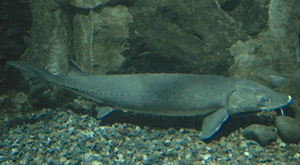
The lake sturgeon, also called the rock sturgeon, and known by scientific name Acipenser fulvescens is one of the best known North American sturgeon species! Found in and around the great lakes, and then across the Mississippi river and Erie canal. Found in 5 differing Canadian provinces and across 24 states stretching from Alabama to Michigan, and as far East as New York. These fish are benthic, spending their time along the bottom of the lake bed, but during spawning these fish will migrate thousands of miles to go back to the stream they were born in.

Like all sturgeon, they are considered living fossils, as sturgeon first appeared in the fossil record upwards of 150 million years ago, with the fish now appearing nearly identical to these ancestors. These fish can get 7 feet or longer, with most being only 4 to 6 feet in length, making them some of the largest sturgeon in North America. Their diet is made up of various invertebrates such as: larvae, small crustaceans, and worms, which they can find along the benthic lake and river beds. The 4 barbels found on these fish have taste buds, which are used to determine what is under their mouth, before they use their prehensile lips to suck up food. When food becomes scarce, these fish are known for migrating for better feeding, which happens semi frequently around the year.

The life cycle of the lake sturgeon is similar to that of most other sturgeons. They begin life as eggs laid in the location their parents were born, in fast paced river streams with lots of flat rocks. The eggs themselves are a bright yellow color, although as the eggs matures this will turn an olive and eventually brown over the course of about 2 weeks. Then they live as larvae only 10mm long, living in and around the dark underside of rocks. After this, as juveniles they will swim to lake environments, where they will spend the majority of their life cycle. These fish can live 55 years long in males and around 150 years for females, with sexual maturity being achieved at an age of around 10 years in males and 30 years in females. Breeding and spawning only happens intermittently every handful of years, and go through around 10 spawning seasons throughout their lifecycle.

For a fun fact to end on for these fish because I'm particularly fond of them, when they reach the stream they will spawn in, these fish are known to porpoise, jumping several feet into the air to end their long journey. That's the lake sturgeon everybody! Have a wonderful day!
#lake sturgeon#rock sturgeon#sturgeon#sturgeons#fish#fish of the day#fishblr#fishposting#aquatic biology#marine biology#freshwater#freshwater fish#animal facts#animal#animals#fishes#informative#education#aquatic#aquatic life#nature#river#ocean
180 notes
·
View notes
Text
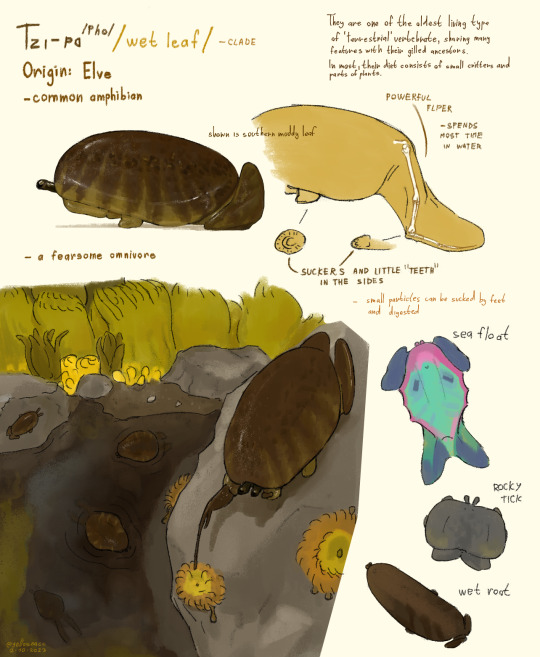
Once again a creature from the continent of Slomen. A very primitive but also very specilised critter. 6 to 30 cm long, wet roots up to 45cm.
They live in many aquatic environments but most often you will find them in forest rivers and lakes. Some species have even adapted for life in the sea and could be considered fully aquatic while still air breathing.
Majority of the clade feeds on small animals like invertebrates sometimes parts of plants they can digest. Their hunting strategy is either burst swimming, jumping or just sliding on top of some slow prey.
There were two important species that started life on land, with the leaf ancestor being a smaller, less land specilised of the two. Leafs are one of their earliest evolutionary branches as land vertebrates and have retained many acient features like paw suckers and teeth instead of claws. In bigger vertebrates most of these little teeth were lost and became true claws or fingers (even present on the other land climber ancestor).
They can actually eat with their feet that are still closely connected to their stomach. But it applies only to very small food particles.
The wets are not very culturally significant but some regions do eat them. But the thick mantle isn't very tasty. In some places they symbolise good harvest season.
These little guys are also related to the 'birds' of Elve and I'm sure you can see why.
#art#speculative biology#artists on tumblr#digital art#artwork#worldbuilding#speculative evolution#spec bio#fantasy#original creature#creature design#spec evo#alien life#frog#slug#elve#pick up and run#speculative fantasy
726 notes
·
View notes
Text
Wet Beast Wednesday: northern pike
It's time for more fun in fresh water with one of the northern hemisphere's primary predatory fish. The northern pike is the tiger of the lakes: a powerful ambush predator that is at the top of the food chain. Popular amongst naturalists and anglers alike, the northern pike is a fairly famous fish. Let's dive in.

(Image: a northern pike seen form the side. It is a long, torpedo-shaped fish with a long head and large jaws. The dorsal and anal fins are very far back on its body. Its body is an olive green with white spots. End ID)
Esox lucius is a large, tube-shaped fish that reaches an average of 40-55 cm (16-22 in) long but can reach a maximum recorded size of 150 cm (59 in) and 28.4 kg (63 lbs). The head is elongated with long, sharp teeth and the most of the fins are far back on the body. The fin placement and body shape allows the pike rapid bursts of speed. The body is an olive green with white spots and a white or yellow underbelly. The head is covered with sensory pores that are an extension of the lateral line and therefore aid in sensing movement. The skin has a thick coating of protective mucus and is easily damaged. The northern pike is similar to the Amur pike (Esox reichertii), Aquitanian pike (Esox aquitanicus), and southern pike (Esox cisalpinus), all of which were previously though to be of the same species as the northern. The northern pike is also similar to the muskellunge (Esox masquinongy) and the two are capable of interbreeding to produce a hybrid called a tiger muskie.

(Image: a northern pike seen from below and the front, showing off its white underbelly. End ID)

(Image: a tiger muskie being held by a fisherman. Its body shape is similar to a northern pike's, but is more silvery with long, greenish stripes. End ID)
Northern pike are found throughout Europe and north Asia, as well as eastern North America. They are found in slow-moving streams and lakes and prefer places with lots of plant cover, which often restricts them to locations nearer the shore. The vegetation is needed both for their hunting strategy and reproduction. During winter and cloudy days and nights, they venture further from the vegetation. Pike are ambush predators that wait motionless in vegetation for prey to pass before attacking with a sudden burst of speed. Pike will pursue prey, but are not as good at long-distance pursuit at many other species of predatory fish. They are known as aggressive fish with a very broad diet including fish, frogs, small mammals, invertebrates, and aquatic birds. There have also been reports of pike attacking dogs and humans, likely while mistaking extremities for small fish. Pike are also aggressive toward each other. They are territorial and will compete for the best hunting grounds. Pike are also cannibalistic and will eat smaller members of their species. Young pike need vegetation as cover to hide from larger pike. Pike are generally solitary animals, though there are reports of pike engaging is what is apparently group hunting. They are somewhat migratory as they will follow migratory prey to their winter habitats.

(Image: a northern pike eating a frog. End ID)
Pike mate during spring, beginning when water temperature reaches 9 C (48 F). They have strong homing behavior, returning to the same breeding grounds where they hatched. Males arrive to the breeding grounds before females do and leave afterwards. Females release thousands of orange, sticky eggs for he males to fertilize. The eggs sink and stick to rocks and plants. Stable conditions above 6 C without high iron concentrations are best for egg development. The young hatch in an embryonic stage that lasts for 5-16 days depending on temperature before transitioning to larvae. The larvae feed on planktonic invertebrates until they reach between 4 and 8 cm, when they switch to feeding on small fish. The mortality rate of larvae is around 95%. Northern pike reach sexual maturity around 2 years and can live up to 25 years, with an average of 10-15 years.

(Image: a juvenile northern pike. It looks like a smaller version of an adult. End ID)
Northern pike are classified as least concern by the IUCN. They are prized by anglers for their size and the fight they put up when hooked. Even when released, their skin can easily be damage by handling, leading to increased mortality. Releasing them when still in the water is recommended. Like many species of sport fish, their average sizes have decreased as a result of overfishing. Because of their popularity as sport fish, northern pike are often stocked in lakes. In eastern North America they have been introduced to lakes outside their native range, leading to them damaging native fish populations. In southern Alaska and Washington they are considered invasive species. Northern pike are edible, though they are bony and need special skill to fillet.

Linking (Video: a pike chasing a lure from the POV of a camera attached to the lure. End ID)
#wet beast wednesday#northern pike#pike#fish#fishblr#fishposting#freshwater fish#freshwater ecology#biology#ecology#zoology#animal facts#informative#educational#image described
81 notes
·
View notes
Text
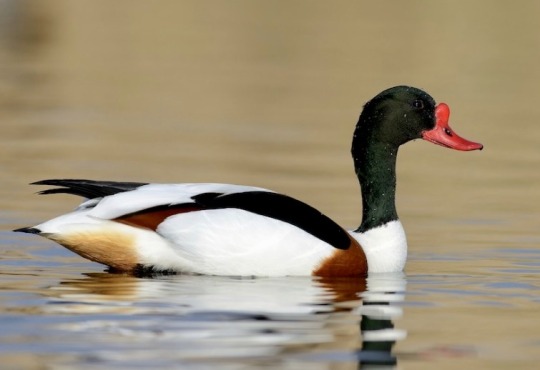


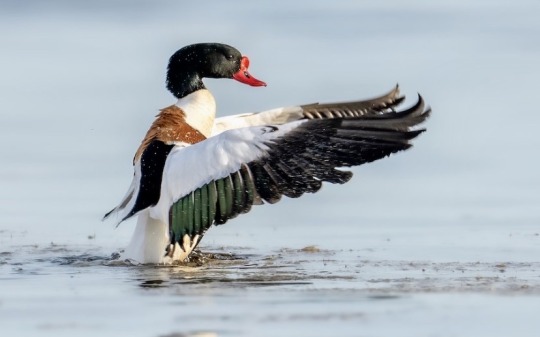

the common shelduck is a migratory duck largely found in eurosiberia. males and females look similar, but males have sharper coloration and lack white markings on the face that are present in females. the species primarily feeds on small invertebrates such as crabs and grasses. during the breeding season, the species is largely found around lakes and rivers; their nests are often made in unusual locations such as rabbit burrows and haystacks.
568 notes
·
View notes
Text



Investigating the Indian Bullfrog
Indian bullfrogs, also known as Hoplobatrachus tigerinus is a large species of frog native to India, Pakistan, and Bangladesh. They are found in many types of freshwater habitat including wetlands, lakes, and urban ponds and rice paddies.
H. tigerinus is one of the larger frog species, weighing anywhere from 0.27 to 0.77 kg (0.6 to 1.7 lb) and measuring about 167 mm (6.60 in) in length; females tend to be larger than males. Outside the breeding season, males and females are virtually identical, with brown or olive green skin and a yellow stripe running down their back. During the breeding season males turn bright yellow, and their vocal sacs turn blue or purple. This bright coloration indicates to females that they're healthy and strong, and the brighter the color the more mates a male will attract.
Breeding for Indian bullfrogs occurs throughout the monsoon season, from July to November. Once they change color, males find a suitable watering hole and begin calling to attract females. After a female chooses a male, other males often attempt to climb on top of the mating pair and insert themselves into the pairing. Once she has finished with her selected mate, the female moves to a quiet area and attaches a clutch of up to 5,000 eggs to underwater vegetation. Several days later the eggs hatch, and tadpoles take several weeks to metamorphose into their adult form. Males reach full maturity in only 10 months, while females take up to two years. Individuals can live up to seven years in the wild.
Outside the mating season, H. tigerinus is nocturnal. They spend most of their time foraging in the leaf litter and brush surrounding their freshwater habitats. Their main diet consists of invertebrates like beetles, worms, and centipedes, and adults will also opportunistically feed on small mammals and birds. Tadpoles are primary predators of mosquito larvae. The main predators of adult Indian bullfrogs are snakes, especially the Asiatic water snake.
Conservation status: The IUCN has rated the Indian bullfrog as Least Concern. They are highly adaptable to urban environments. The species has been introduced in many countries outside its native range, including the Maldives and Madagascar, where it is considered an invasive species.
Photos
Kishan Meena
H. H. Harikrishnan et al.
Danile Nasika
#indian bullfrogs#Anura#Dicroglossidae#fork-tongued frogs#frogs#anurans#amphibians#freshwater fauna#freshwater amphibians#wetlands#wetland amphibians#urban fauna#urban amphibians#asia#south asia#india#animal facts#biology#zoology#ecology#nature
130 notes
·
View notes
Text

New Damsel
A very recently emerged damselfly, yet to develop any colouring, drying in the sun on a reed leaf at RSPB Fen Drayton Lakes.
#cambridgeshire#canon#canonuk#damselflies#damselfly#fauna#fen drayton#fen drayton lakes#insect#insects#invertebrate#invertebrates#minibeast#minibeasts#nature#nature reserve#outdoors#rspb#wildlife
9 notes
·
View notes
Note
What does agriculture and typical plants and animals used in food look like in different regions and cultures?
For the sake of brevity, my answer will only cover this part (but don't worry, I'm working on the plants (and invertebrates) as well) :
VERTEBRATE LIVESTOCK OF UANLIKRI

Thanks to a wide range of environments and intercontinental trade, Uanlikri boasts a wide variety of vertebrate livestock, some domesticated locally, others brought along by settlers from the other continental masses. Most livestock on Uanlikri are ceratopsians (some more highly derived than others).
Caviþ
Pronounced chavith. Caviþ are a highly derived species of ceratopsians originating from the Basin region. The wild species still exist, roaming the southern Basin plains in great hordes.
For the most part, caviþ are kept as beasts of burden and for their meat and leather. In most locales, they are unpopular compared to O'ohu, which are more powerful, meatier, more docile, and have more offspring at once. Nevetheless, keeping caviþ has its avantages: caviþ are smaller, hardy, tolerant of crowding, and produce rough but warm pelts.
In general, caviþ are too small to be ridden by adult antioles, but not for the Apinaat and Abimaat, two peoples of pigmies who make their living on caviþback across the southern Basin plains and on the Matar Peninsula. For the Apinaat and Abimaat, caviþ, wild and domestic, are their whole livelihood. Their use of caviþ as mounts gives them an incomparable edge in warfare and has earned them a fearsome reputation.
Wek
Wek are one of the few non-ceratopsian livestock originating from Uanlikri. They were first domesticated in coastal areas of the Pwetitwì range from large gull-like birds, and spread from there to most northern coastal areas of Uanlikri. Wek are meaty and adaptable birds kept for their eggs, plumage, and guano. They require access to open water to thrive, but accept saltwater and freshwater alike. They are primarily kept in coastal areas, as well as along the Koramme river and Basin Great Lakes, where the slow-moving waters suit them fine.
Kabi
Kabi, a guinea pig sized ceratopsian, are the most widely kept livestock on Uanlikri. The kabi in the picture was enlarged for ease of viewing: the vast majority of kabi breeds are much smaller, though giant breeds do exist. Kabi are a multi-purpose livestock: they are bred for their meat, abundant eggs, soft patterned pelts, and companionship. Kabi are extremely adaptable and very tolerant of crowding. Their ease of keeping in urban environments has made them ubiquitous through all the cities of the continent.
There are hundreds of kabi breeds and landraces on the continent. Kabi have a tendency to establish themselves as feral pests as well as livestock, where natural selection by the environment encourages the development of landraces best adapted to the local climate. They also make excellent pets due to their highly social nature, and many lines of kabi are bred purely for good temperament and pleasing (though sometimes extreme) appearance. Kabi are also ubiquitous overseas: it is unclear where they were first domesticated, but most theories point towards dwarf and standard kabi originating from one domestication event on Uanlikri, and red-leg kabi originating from another domestication event overseas, possibly of a different but related species: this would explain some of the difficulties in breeding dwarf and standard kabi to red-leg kabi.
Tsut
Tsut were one of the livestock species brought along by the Senq Ha Empire, conquerors and settlers of the Western Peninsula. These diminutive therizinosaurids were selected through millenia for an extremely downy, frizzy coat which can be sheared and spun like wool. Of all Senq Ha livestock, tsut were the ones to find the fastest and most widespread adoption, only limited by their destructive browsing habits and preference for hilly terrains and cool weathers. Tsut down revolutionized the world of textiles in Uanlikri, where spun-down fibres were previously very rare and very expensive, requiring capture and shearing of wild animals with very little suitable fibre.
Tsut are primarily raised for their fiber but also provide meat and more importantly crop-milk. Consumption of crop-milk is slow to catch in communities not descended from the Senq Ha, but the Senq Ha's people use crop milk abundantly, using it fresh or processed in dozens of different ways.
Llekme
Llekme were domesticated in the Northern peninsulas of Uanlikri from a species related to the caviþ. They share many of the caviþ issues and advantages, being hardy but temperamental. However, contrarily to the caviþ, they are an extremely popular livestock among both sedentary and nomadic populations Uanlikri's north. There, they are used as beasts of burdens and pulling animals of limited power as well as for their meat. For the desert nomads of the Atashir, llekme provide essential help in carrying their tents and tools; in cities, they are often used as pulling animals, working alone or in teams to pull small carts and coaches.
Hêtâ
Hêtâ are family of highly derived ceratopsians, including a dozen species and subspecies on the mainland and a few endemic island species. They are, in truth, not yet a domestic species. All species of hêtâ are game animals highly appreciated for their ornemental feathers and delicious meat, and there have been several attempts to domesticate various species of mainland hêtâ, none of which have been successful. Mainland hêtâ have extremely nervous dispositions, are prone to dying from stress, and mostly fail to reproduce in captivity: they rarely breed, and when they do, they most often do not provide parental care, leading to the death of the chicks.
This said, there is an ongoing project on the Ojame archipelago to restore and domesticate the near-extinct Ojame hêtâ. The Ojame hêtâ is endemic to the archipelago. Due to the absence of large predators on the archipelago, it has evolved to be larger and much less fearful than mainland hêtâ, but was driven to near extinction by hunting and the introduction of larger, bolder breeds of oujabe [dog analogue] from the mainland and of continental hêtâ imported for use as wild game.
The failure of mainland domestication attempts and a joint desire to preserve and profit from the Ojame hêtâ has led to a unique, unusually coordinated project to domesticate and reestablish the Ojame hêtâ. In a rare show of goodwill and collaboration, this project is shared by both Wetki and Ranaite communities on the archipelago. The Ojame hêtâ is thought to be a promising source of meat and ornemental feathers as its population levels rise and stabilized. Successful captive reproduction has been achieved, and semi-domesticated captive population are being reintroduced to Êrar, the archipelago's largest island where the hêtâ had been completely eradicated.
Wagwacguk
The wagwacguk (wag-wash-guk) is a wild animal living as familial herds in the tundras south of the Kantishian, with a domestic subspecies of marginal range in the lands of the Daghwa-Igdø and the Kantishian High Plateau. It is a large, extremely hardy animal with a warm, plush coat and thick leather. For the Daghwa-Igdø, wagwacguk are their main livelihood. One month per year, they feast on the fresh meat of wagwacguk calves, culling their herds as the first dayfrosts touch their lands; the later kills are preserved by smoking and freezing. The rest of the year, wagwacguk blood provides them with most of the protein in their diet. Wagwacguk pelts, leather, guts, horn and hooves are the materials involved in most of their material culture.
Though domestic wagwacguk are most closely associated with the Daghwa-Igdø, they are also kept by the Oubixwø-øi of the Kantishian high plateau as part of the Oubixwø-oi's diverse survival strategies.
O'ohu
O'ohu are domestic hadrosaurs named, in most regions where they are kept, after their loud and haunting cry. They are the largest and second-most widespread livestock on Uanlikri. Where they are kept, they are invaluable for their work as beasts of burden: plowing fields, pulling carts, carrying charges of all kinds. They are essential to the work of peasants and armies alike, and they are surprisingly fast. Historically, they have often been used in active combat, pulling war chariots. They cannot be ridden: their back ridge is too fragile to bear the weight of a rider and their alternatively bipedal and quadrupedal gait makes balancing a saddle impossible. They are also used for meat, blood, leather, and other byproducts. Their finely scaled and patterned leather is considered especially attractive, and their hollow horns are often made into music instruments. In many cultures, O'ohu grastroliths are considered to have medicinal properties as the ultimate digestive aid, and are often sold at a considerable markup by gastrolith merchants.
#worldbuilding#uanlikri#speculative biology#speculative evolution#dinosaur#antiole world#art by me#asks#feel free to send the agriculture and plants asks again btw i'm working on it I just felt this would get wayyy too long#caviþ#chavith#kabi#llekme#wek#hêtâ#heta#tsut#wagwacguk#o'ohu#long post
74 notes
·
View notes
Note
Do you have any cool facts about Missouri wildlife?
I'd love to share something with my Midwestern friends, and thank you for always updating this blog!
I don't know if i have any Missouri animal facts per se... but I can share some of the state symbols with everyone.
We moved around a lot when we first came to the U.S. and we lived briefly in Kansas City. I have great memories of going to the Ozarks at Christmas time (near Lake of the Ozarks). I specifically remember following woodpeckers and deer around the forest in the snow.
SOME MISSOURI STATE SYMBOLS:
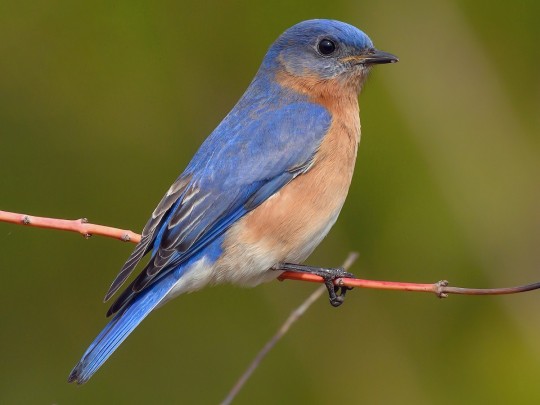
STATE BIRD: Eastern Bluebird (Sialia sialis), family Turdidae, order Passeriformes, found across much of the central and Eastern U.S., SE Canada, and NW Mexico
Changes in land use lead to drastic declines in Eastern Bluebirds after the early 1900s. They have recovered in many places, due to "bluebird trails", reestablishing appropriate habitat and nest box campaigns for public and private property.
Find out more: NestWatch | Eastern Bluebird - NestWatch
Blue birds are in the thrush family, Turdidae, along with American Robins.
They eat mainly worms, insects, and other small invertebrates (but also take berries for part of the year).
Bluebirds are cavity nesters, nesting in tree holes usually, but will readily take to properly constructed and placed nest boxes.
Males (pictured) are brighter blue, and females are a more muted and faded blue or bluish gray.
photograph by Keith Kennedy
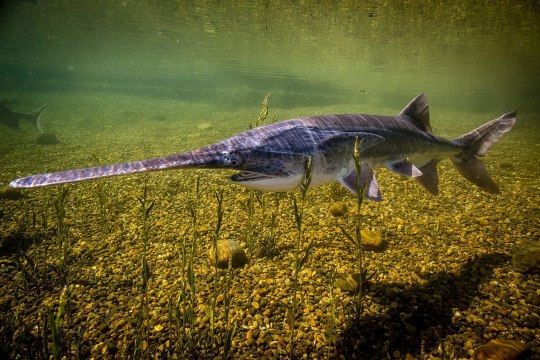
STATE AQUATIC ANIMAL: American Paddlefish (Polyodon spathula), family Polyodontidae, order Acipenseriformes, found in various parts of the Mississippi River basin
This species is the only member of this family that still exists. They are most closely related to sturgeons. This order, Acipenseriformes, is considered one of the most evolutionarily primitive groups of ray finned fishes.
They do not have scales, and their skeleton is mostly cartilaginous.
They are filter feeders. Their heads and rostrums are covered with thousands of sensory receptors, which help them locate zooplankton swarms.
They are considered "vulnerable" due to overfishing, habitat degradation and destruction, and pollution.
photograph via: US Fish & Wildlife Service
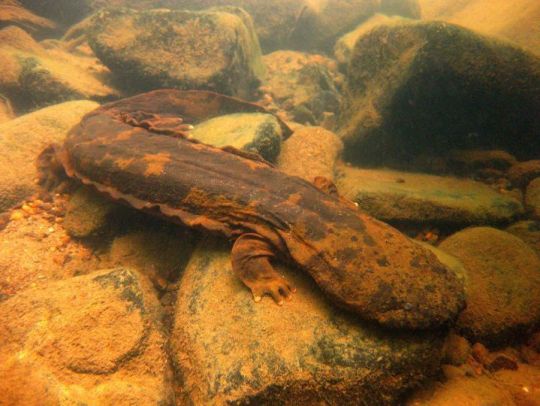
STATE ENDANGERED ANIMAL: Eastern Hellbender (Cryptobranchus alleganiensis), family Cryptobranchidae, eastern United States
The largest salamander in the Americas, it grows to a total maximum length of up to 40 cm (15.7 in).
Though nationally it is considered to be just "vulnerable", in some states (like Missouri), it is "endangered".
photograph by Mark Tegges
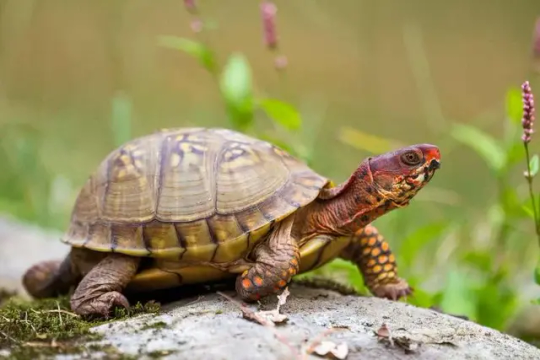
STATE REPTILE: Three-toed Box Turtle (Terrapene triunguis), family Emydidae, found in the South-central and Southeastern U.S.
This specie shas been considered to be a subspecies of the Eastern Box Turtle, T. carolina (and still is by some herpetologists).
These turtles are terrestrial, but are not closely related to tortoises. They are in the same family as aquatic sliders, pond turtles, cooters, map turtles, and painted turtles.
photograph by Noppadol Paothong
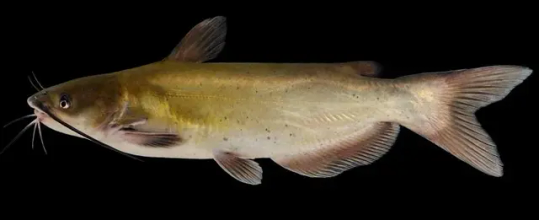
STATE FISH: Channel Catfish (Ictalurus punctatus), family Ictaluridae, order Siluriformes, found in freshwater habitats in the eastern and southern US, southern Canada, and northern Mexico
They are widely caught, and have been introduced into waterways in other parts of North America and around the world. (In some places they are considered an invasive species).
photograph via: Missouri Dept. of Conservation

photograph by Brian.gratwicke
#Acipenseriformes#paddlefish#fish#ichthyology#box turtle turtle reptile#herpetology#bluebird#thrush#bird#ornithology#north america#hellbender#salamander#amphibian#animals#nature#catfish
181 notes
·
View notes
Text
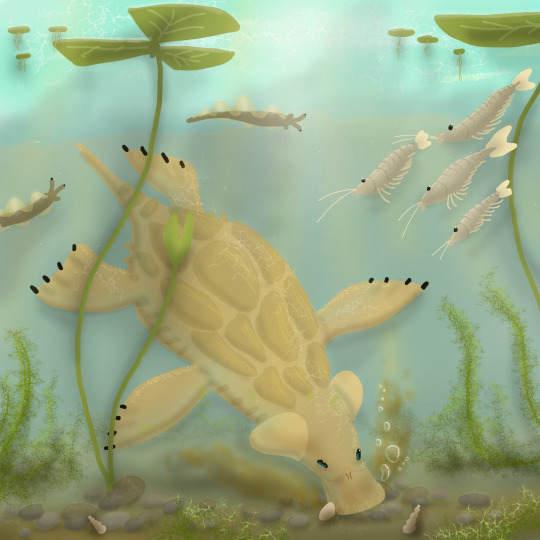
'While some of the armored rattiles known as shingles live firmly on dry land, and another class, the seashingles, living entirely in the open ocean, some species dwell in the numerous inland bodies of fresh water all so abundant in the Middle Temperocene, with its ponds, lakes and streams conducive to the flourishing of an assorted diversity of life. The pond turtduck (Anatochelymys atla) is one such species of freshwater shingle, foraging at the bottom of ponds with its broad flattened snout to feed on an assortment of food, ranging from algae and aquatic plants to freshwater snails, clams, worms and other invertebrates that it stores in its cheek pouches and chews when it surfaces to breathe. Found mostly across Gestaltia's tropical regions, the pond turtduck, defended by its sturdy skeleton and protective keratinous armor plates, is largely unconcerned with enemies, feeding at its own leisurely pace--though, if an aggressor proves persistent, the sharp raking claws on its flipper-like limbs acts as an additional deterrent, particularly on land where the turtduck is clumsy and unsuited for a quick getaway.'
-----------
#speculative evolution#speculative biology#spec evo#speculative zoology#hamster's paradise#art one shot
124 notes
·
View notes